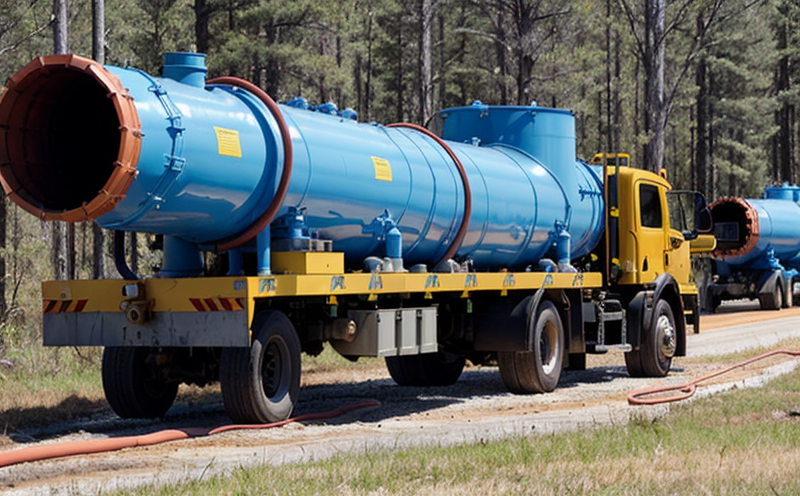IEC 60529 IP Protection Testing of Gas Pipeline Components
The International Electrotechnical Commission (IEC) Standard IEC 60529 defines the degrees of protection provided by enclosures against access to hazardous parts and against ingress of foreign objects. This standard is crucial in ensuring that electrical equipment, including those used in gas pipeline systems, meets required safety standards.
In the context of natural gas distribution and pipeline safety testing, IEC 60529 IP ratings are essential for preventing unauthorized access to critical components while also safeguarding against ingress of harmful substances like water or dust. This standard is widely adopted across various sectors including power utilities, oil & gas, and industrial manufacturing.
The importance of this testing cannot be overstated; it ensures that the integrity and safety of natural gas distribution systems are maintained. In environments where safety is paramount—such as those involving flammable gases like methane—the correct IP rating can make a significant difference in preventing accidents or leaks that could lead to explosions or other hazards.
Testing for compliance with IEC 60529 involves several steps, starting from the design phase. Engineers must consider not only the physical structure of the component but also its operational environment. This includes factors like humidity levels, temperature ranges, and potential exposure to corrosive elements. Once designed, prototypes undergo rigorous testing using specialized equipment that simulates real-world conditions.
One critical aspect of this process is understanding what constitutes an acceptable level of ingress protection for different applications within the pipeline network. For instance, a component located in a dry area might need less stringent IP ratings compared to one situated near coastal regions where higher humidity and salt spray are present. By adhering strictly to IEC 60529 guidelines during both design and testing phases, manufacturers ensure their products meet global standards for safety and reliability.
Testing laboratories specializing in this field employ advanced instrumentation capable of accurately measuring various parameters related to IP ratings. These include pressure differentials across the tested sample, water spray angles, and duration times required to determine if ingress occurs. The results are then compared against specified criteria outlined in IEC 60529 to assess whether a given product meets the necessary standards.
Compliance with these stringent requirements helps protect both personnel working on or near gas pipelines as well as the general public who rely on safe and efficient delivery of natural gas. It also contributes significantly towards minimizing environmental impacts associated with leaks or accidents involving hazardous materials.
To summarize, IEC 60529 IP protection testing plays a vital role in ensuring that components used in natural gas distribution systems are robust enough to withstand the rigors of their operational environments while remaining safe from unauthorized access. By adhering closely to this standard throughout all stages of product development and deployment, manufacturers can help guarantee the highest levels of safety and reliability for critical infrastructure.
Scope and Methodology
| Test Parameter | Description | Acceptance Criteria |
|---|---|---|
| Water Jet Test | Above a certain pressure, water jets are directed at the specimen from multiple angles. | No ingress of water is allowed under any test condition. |
| Sand and Dust Test | Dust particles are blown onto the surface of the specimen to simulate real-world conditions. | Less than 1% mass loss or equivalent visual change in appearance is acceptable. |
| Humidity Testing | The specimen is exposed to high humidity levels for extended periods. | No visible condensation on the exterior surface of the specimen after exposure. |
| Vibration Testing | The specimen undergoes controlled vibration cycles to simulate transport conditions. | Minimal change in mechanical properties as measured post-test. |
The scope of IEC 60529 IP protection testing encompasses a wide range of parameters designed to evaluate the effectiveness of different degrees of protection offered by enclosures against ingress. Each test parameter has specific acceptance criteria aimed at ensuring that the tested component meets or exceeds industry standards for safety and reliability.
Environmental and Sustainability Contributions
- Emissions Reduction: By ensuring proper sealing of pipeline components, IEC 60529 testing helps reduce leaks of natural gas into the atmosphere. Methane leakage contributes significantly to greenhouse gas emissions.
- Resource Efficiency: Properly sealed components last longer, requiring fewer replacements and thus reducing resource consumption over time.
- Energy Conservation: Leak-free systems operate more efficiently, conserving energy resources.
- Eco-Friendly Manufacturing: Compliance with IEC 60529 ensures that products are designed sustainably from the outset, minimizing waste and promoting circular economy principles.
The sustainable practices associated with this testing contribute to broader environmental goals by enhancing resource efficiency and reducing emissions. These efforts align with global initiatives aimed at combating climate change while supporting long-term sustainability in infrastructure development.
Competitive Advantage and Market Impact
Adhering to IEC 60529 IP protection testing can provide significant competitive advantages for companies operating within the natural gas distribution sector. Compliance with these stringent standards demonstrates a commitment to quality, safety, and environmental responsibility that resonates positively with customers, stakeholders, and regulatory bodies alike.
From a business perspective, meeting IEC 60529 requirements signals to potential clients that your organization prioritizes product integrity and operational reliability above all else. This can translate into increased market share as consumers increasingly favor brands known for their dedication to sustainability and safety.
In terms of regulatory compliance, being ahead of the curve on this standard ensures smooth interactions with authorities responsible for enforcing electrical safety regulations. It allows companies to anticipate future changes in standards and adapt accordingly without disruption to ongoing operations or supply chains.
Moreover, successful implementation of IEC 60529 testing procedures fosters innovation within R&D departments by encouraging exploration into new materials and technologies that enhance protection levels beyond current norms. Such advancements could lead to breakthroughs beneficial not only to your company but also the entire industry ecosystem.





